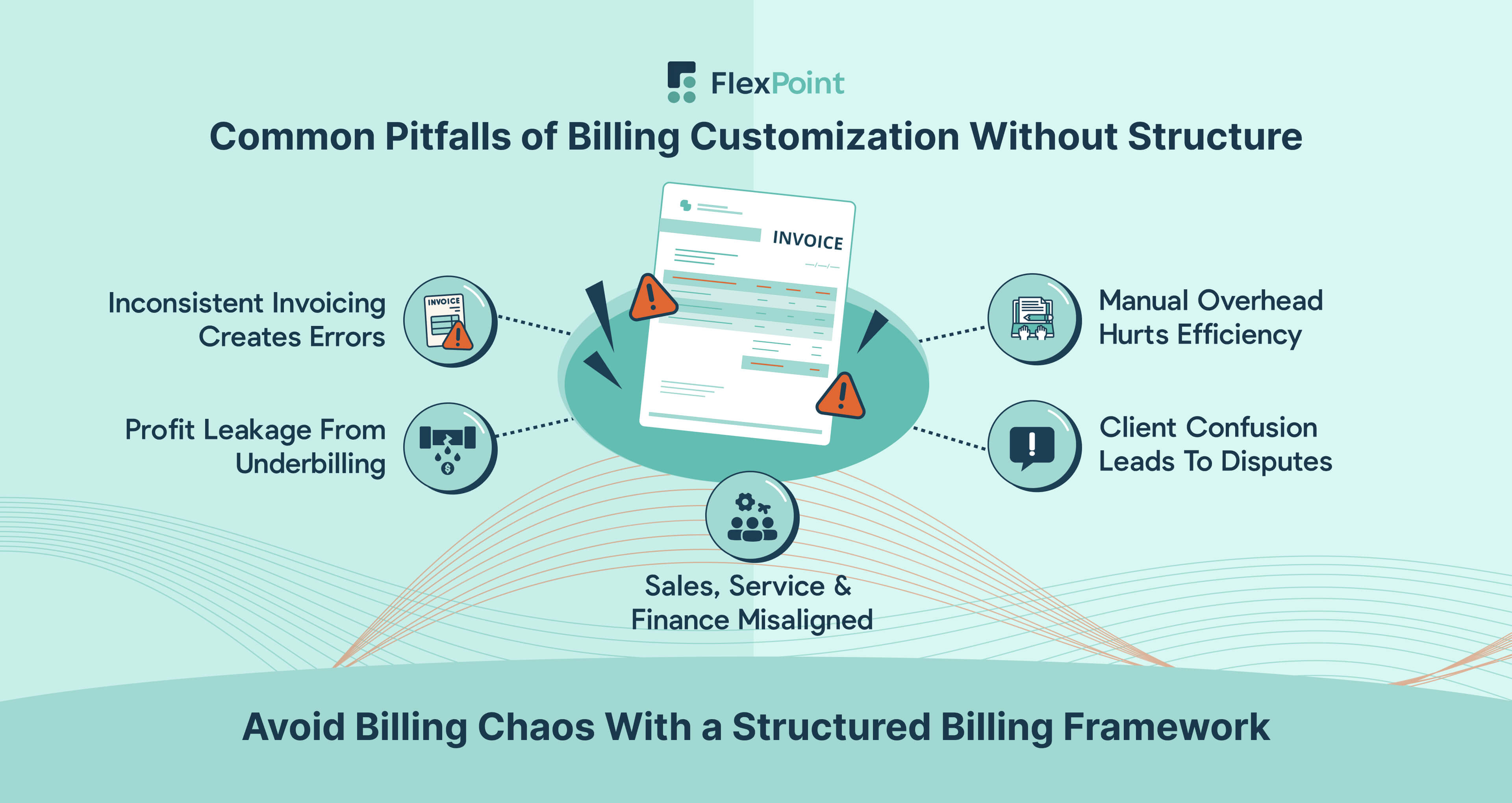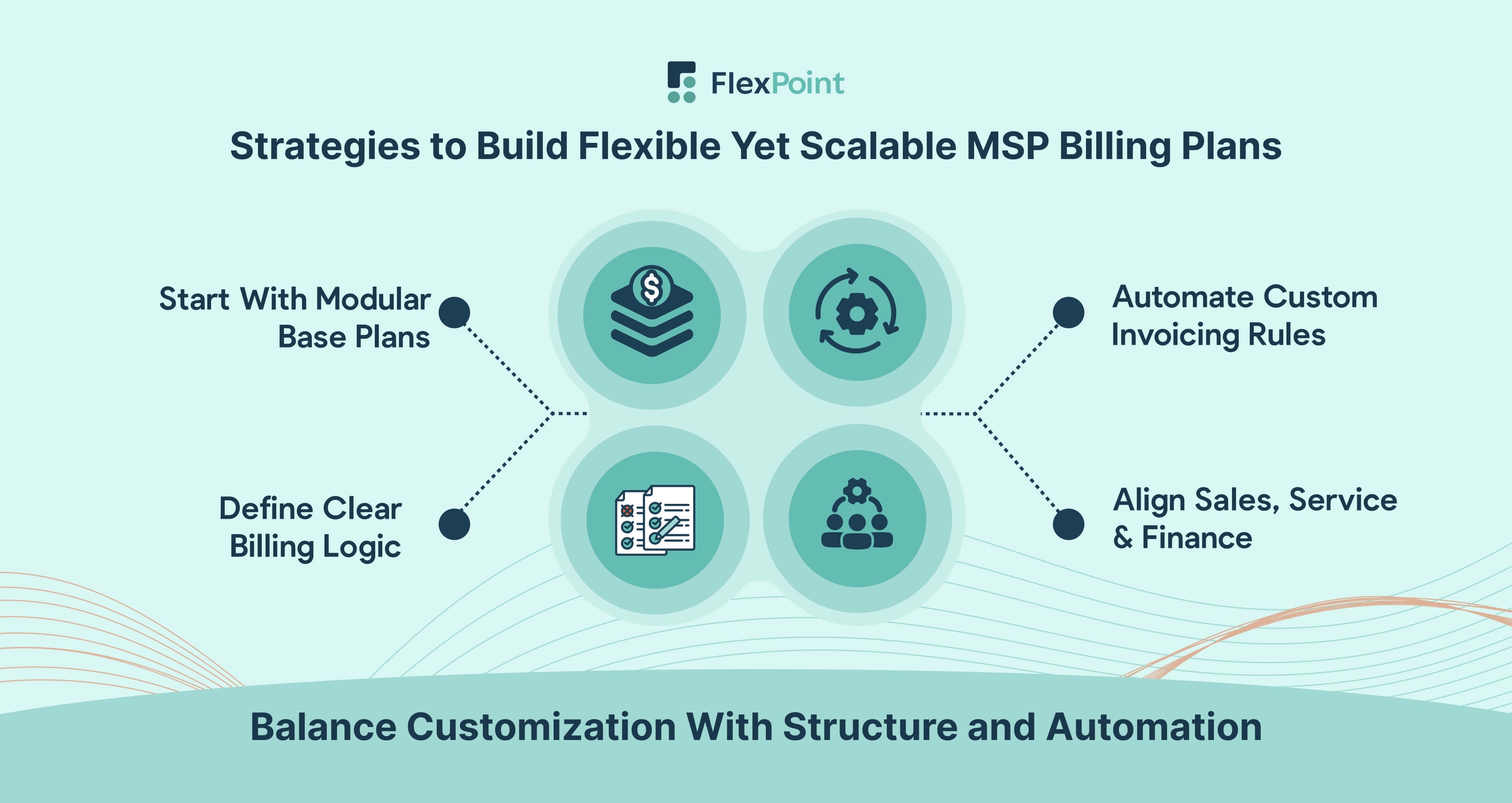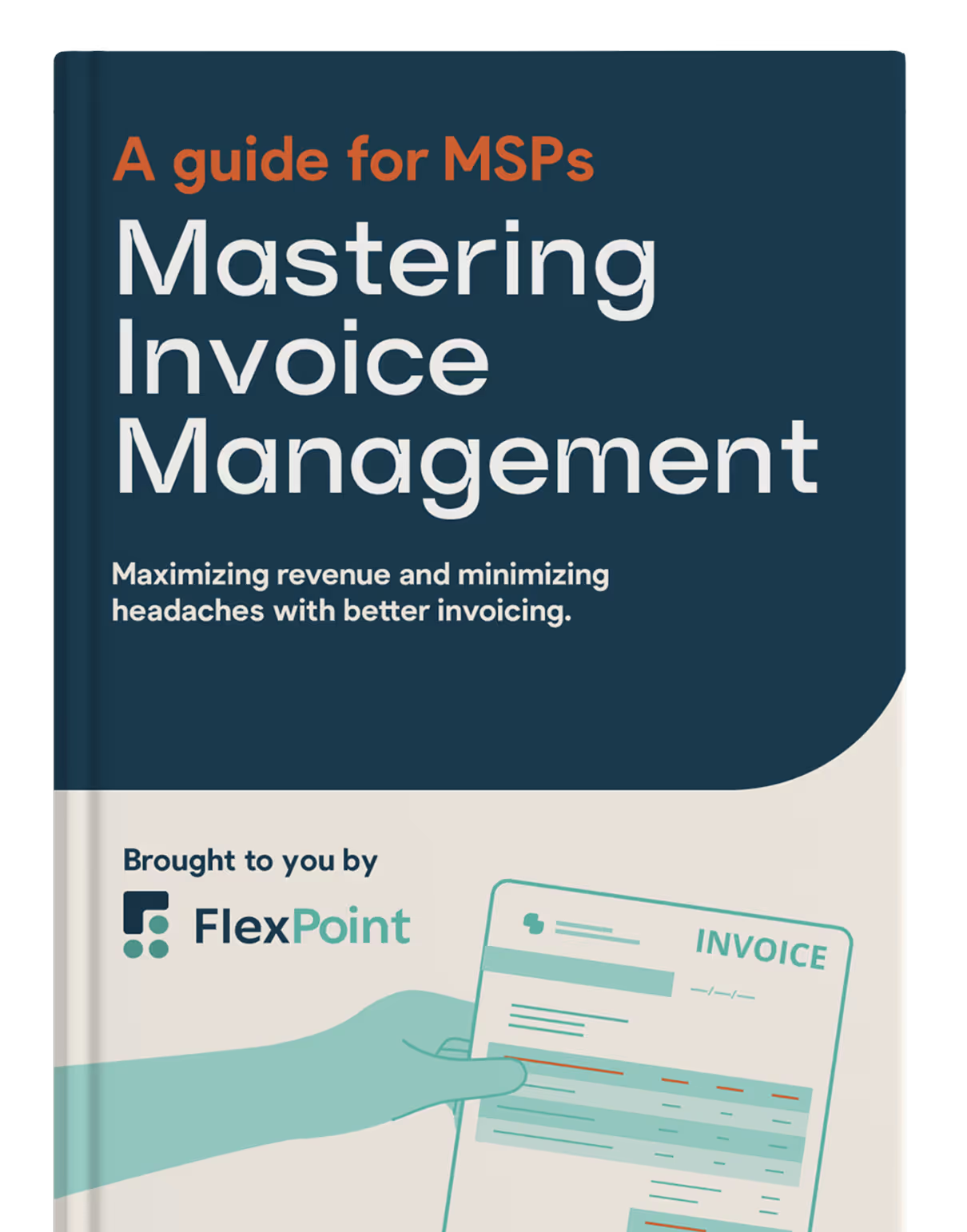MSP Customizable Billing Plans: Flexibility to Fit Every Client’s Needs

Managed service providers (MSPs) face growing pressure to offer flexible billing plans tailored to each client’s needs. Business clients are increasingly demanding personalized pricing and payment options, rather than one-size-fits-all service packages.
This shift is occurring as the global managed services market, valued at USD 335.37 billion in 2024, is projected to grow at a 14.1% compound annual growth rate (CAGR) through 2030, according to Grand View Research.
This growth is driven by demand for cloud optimization, expert technology consultancy, and scalable infrastructure support. In a market expanding this quickly, MSPs that adapt their billing to meet individual client requirements are better positioned to compete and capture new opportunities.
However, offering customized billing is a double-edged sword: it can significantly improve client satisfaction and loyalty, but it also introduces risks if not managed with structure. The key is finding a balance between flexibility and control.
This means that MSP owners and finance teams need to enable personalization without disrupting their operations or eroding profitability.
In this article, we will explain what customizable billing plans are and why they matter, then detail how to implement them in a controlled and scalable way.
We will also examine real MSP examples and strategies, including how MSP-specific payment automation tools streamline custom billing, allowing you to deliver bespoke plans without compromising clarity or revenue.
{{toc}}
Why MSPs Are Offering Customizable Billing Plans
Customizable billing plans enable MSPs to tailor services, pricing, and payment terms for each client, rather than forcing everyone into predefined “bronze, silver, gold” packages.
In practice, this means flexible billing and payment policies shaped to a client’s profile and needs.
MSPs are moving in this direction for several reasons:
1. Evolving Client Expectations
Clients now expect vendors to meet them on their terms. A fixed monthly plan with identical features for all may not address a specific client’s pain points or usage patterns.
Every client is unique, and MSPs are realizing they must tailor pricing to each client’s specific needs rather than forcing everyone into a generic box.
This is especially true for co-managed IT arrangements where the MSP works alongside an internal IT team. Co-managed IT services are inherently flexible and customizable, so the billing must adapt accordingly.
2. Market Differentiation
The managed services industry is booming and highly competitive. Offering personalized billing can help an MSP stand out. It signals a client-centric approach—you’re not just selling a fixed menu, but crafting a solution tailored to each business. This differentiation can be crucial in winning deals.
For example, rapidly growing MSPs may find that they need creative billing options to attract large enterprise clients.
By leveraging FlexPoint to offer flexible payment terms (installment plans) on big projects, MSPs can pursue high-profile contracts that previously seemed out of reach.
3. Client-Specific Needs
On the flip side, MSPs recognize the risk of not offering any customization. If you force all clients into the same fixed packages, you may lose prospects who feel those plans don’t fit them.
If MSPs offer clients a tiered menu or options of pricing models, clients may choose the cheapest option without carefully considering the alternatives, which can lead to poor outcomes for both the client and the MSP.
If an MSP refuses to budge on billing structure, a prospect may look elsewhere for a provider willing to be more flexible.
According to Allianz, 30–50% of B2B buyers have abandoned purchases because their preferred payment or pricing option wasn’t available.
The message is clear: some level of pricing customization is becoming expected, and MSPs risk losing business if they only offer rigid plans.
In summary, MSPs are embracing customizable billing plans because clients expect them, they help differentiate their services, and they align the MSP-client relationship more closely. But without an intentional approach, customization can lead to operational headaches.
Next, we’ll explore the benefits of offering custom plans and common pitfalls to avoid.
{{ebook-cta}}
The Benefits of Offering Custom Billing Plans and Payment Options to MSP Clients
When implemented well, tailored billing plans can create a win-win scenario for MSPs and their clients.
Notable advantages include:
1. Higher Client Satisfaction and Loyalty
Clients feel heard and valued when their MSP provides a plan tailored to their business needs. Customized pricing models and payment solutions have been proven to enhance client satisfaction and foster long-term relationships.
Clients who see their MSP accommodating unique needs are far more likely to stay for the long haul.
In short, billing flexibility secures loyalty in ways that rigid plans cannot.
2. Competitive Edge in New Client Acquisition
A flexible approach to pricing and packaging is a powerful differentiator when MSPs are competing for new business.
Rather than saying “take it or leave it” with a generic plan, you can propose creative solutions (different service bundles, payment schedules, financing options, etc.) that competitors might not offer.
This adaptability demonstrates a client-first mentality. In fact, businesses that allow multiple payment arrangements, on average, spend 20–40% more on purchases, according to B2B BNPL specialist Two.
This indicates that flexible options not only please clients but can lead to larger deals for the MSP.
3. Upsell and Cross-Sell Opportunities
Customizable plans make it easier to add on services over time. Since each client’s package is not constrained to a fixed tier, you can introduce new components as their needs evolve.
For example, suppose a client initially only buys basic tech support. In that case, you might later upsell a security add-on or cloud backup service as a seamless extension of their custom plan.
This tailored approach aligns with actual needs, making clients more receptive to upgrades (as opposed to trying to move them from one tier to a higher, more expensive tier that includes lots of extras they may not want).
This means that flexible plans can actually increase revenue per client by allowing tailored add-ons and changes without a contract overhaul.
4. Better Alignment with Client Value
With personalized billing, clients pay for what they truly need and value. This creates a sense of fairness and alignment.
For example, a client who mainly needs after-hours support can have a plan emphasizing that, whereas another who needs intensive on-site service can have a plan (and price) reflecting the extra effort. Each client sees a direct link between their costs and the value they receive.
This alignment boosts the perceived value of your services. Clients feel they are getting a bespoke solution and not overpaying for irrelevant extras. It can also improve trust since the billing is transparently based on their specific agreement.
5. Improved Cash Flow and Value Perception
When billing is tailored, MSPs can structure payments in a way that benefits both parties.
For example, offering quarterly or usage-based billing for a client who prefers it might encourage prompt payment and smoother cash flow, compared to forcing a model that doesn’t suit them.
Flexible billing options (like installment plans or adjusting fees to business seasonality) can reduce late payments and disputes.
Additionally, a client on a custom plan may be more understanding about charges because everything has been clearly defined for their situation. The overall perception is that the MSP is a partner invested in the client’s success, not just a vendor with inflexible policies.
In summary, personalized billing plans lead to happier clients, more revenue opportunities, and stronger partnerships.
Next, we’ll examine the potential pitfalls that can arise when customization is done haphazardly or without structure.
5 Common Pitfalls of Billing Customization Without Structure

While customization has clear upsides, doing it without a plan can cause serious issues.
Here are common pitfalls MSPs face if they offer highly variable billing arrangements without proper controls:
1. Inconsistent Invoicing and Complexity
If every client has a different billing schedule, pricing formula, or set of included services, your invoicing process can become very complex. Manually keeping track of who gets billed for what (and when) is error-prone.
Small mistakes, such as forgetting a charge or using the incorrect rate, can slip in when invoices aren’t standardized.
Inconsistency also means your team might send out invoices late or with differing or inconsistent formats, which appears unprofessional.
Ultimately, without a structured invoicing system, offering different services to different clients can lead to confusion, frustration for your billing staff, and chaos for clients.
2. Profit Leakage and Underbilling
Custom deals made on the fly can inadvertently undercut your margins. A common mistake is agreeing to special terms or discounts for a client and then failing to account for all the work you perform.
Unstructured customization often means things like usage overages or out-of-scope tasks go untracked and unbilled. Untracked usage and bundled extras usually result in underbilling and missed revenue for MSPs.
If an MSP doesn’t have a way to monitor when a client exceeds their included hours or adds new devices, those overages may never be included on an invoice. Over time, these errors quietly erode profit.
3. Misalignment Between Sales, Service, and Finance
When plans are tailored to each client, all departments must share a common understanding of what is included for each client.
If not, problems arise—sales might promise something the service team isn’t aware of, or the service team might deliver work that finance doesn’t bill for.
Without a clear record of each client’s agreement, situations can arise where technicians provide support beyond the contracted scope (thinking it’s covered) or accounting invoices something incorrectly.
Internal misalignment, such as this, leads to either over-servicing (harming profitability) or billing disputes. Disconnected systems exacerbate this risk. For instance, data entry errors and inconsistencies are more likely if your PSA, accounting, and payment tools are not synced.
A structured approach is necessary so that everyone, from account managers to support engineers to bookkeepers, is aware of each client's specific plan details.
4. Manual Overhead and Inefficiency
Customized billing can dramatically increase the workload on your finance team if you lack automation. Imagine manually adjusting invoices for dozens of clients each month because each has unique terms.
Many MSPs fall into using spreadsheets or manual processes to track these client-by-client differences. This is tedious and scales poorly as your business grows.
Manually compiling hours, reviewing contract terms, and applying the correct custom pricing for each client can be a time-consuming process.
It also delays your billing cycle (hurting cash flow) and increases the chance of human error.
5. Client Confusion or Disputes
If custom billing isn’t handled transparently and accurately, it creates payment friction with clients.
For example, if a client’s invoice varies wildly from month to month without clear documentation, they may become confused or distrustful. Errors, such as missed credits or incorrect charges on a bespoke plan, can quickly harm the relationship.
Mistakes in invoices can frustrate your clients and even lead to disputes if billable services are omitted or charges seem unexpected. Inconsistent billing can make clients feel they’re being mistreated compared to others, unless you communicate clearly.
Thus, unstructured customization without clear guidelines often results in more client inquiries and complaints about billing, not fewer.
In summary, offering custom plans without a solid framework can lead to invoicing chaos, lost revenue, internal confusion, heavy administrative burden, and unhappy clients. The good news is that these pitfalls can be avoided.
4 Strategies to Build Flexible Yet Scalable MSP Billing Plans

To successfully offer customizable billing plans without losing operational clarity, MSPs should introduce structure and automation into their billing process.
Here are four strategies to achieve flexible yet scalable billing:
1. Start With a Modular Base Plan Structure
Begin by establishing a modular service catalog as the foundation of your offerings. Define a set of core services and add-on modules that can be combined to create custom packages. This strategy creates consistency across all client agreements.
For example, you might have a base managed IT package (covering standard helpdesk, monitoring, and patching) and optional modules for advanced security, cloud backup, VCIO services, and more.
This way, each client’s plan is essentially a tailored bundle of predefined components. It provides flexibility (clients can select what they need) without the MSP having to create unique line items for every client.
A modular approach keeps your services standardized to a degree, making them easier to support and bill for. It also simplifies pricing, as each module has a set price or rate, allowing you to plug those into a custom quote rather than calculating entirely new prices every time.
The result is structured flexibility; you can say “yes” to client requests by selecting the right mix of modules while maintaining a controlled catalog of services.
From an operational standpoint, modular plans mean your team is familiar with the menu of services and how they are billed. It avoids the scenario of entirely one-off services that technicians might not be familiar with or that don’t align with any established process.
MSPs that succeed with custom plans often still standardize their offerings under the hood, using modules or templates. This strategy provides a common framework to all your deals, making customization scalable.
2. Define Clear Billing Logic for Each Client
When you do customize a plan for a client, document the billing logic and scope in clear terms, both in the contract and in your internal systems. This is about ensuring that everyone knows exactly what the client’s arrangement includes and how charges will be applied.
Key details to define upfront include:
- Billing frequency (e.g., monthly recurring services, quarterly plans, annual renewals)
- Included quantities (e.g., support for X users or devices, X hours of onsite support)
- Rates for any overages or extra services, and what is considered out-of-scope
By spelling this out, you prevent misunderstandings later.
For instance, your Master Service Agreement or proposal should state how out-of-scope work is handled (e.g., billed at an hourly project rate).
Internally, it’s wise to configure each client’s profile in your PSA or billing system to match these rules. If a client has a custom rate or a unique discount, enter that into the system rather than relying on someone’s memory each month.
Document those rules in a central location accessible to sales, service, and finance teams. Clarity here ensures that when the service team delivers work and the finance team bills for it, they are both aligned with what was sold.
3. Automate Recurring and Custom Invoicing Rules
Manual invoicing and spreadsheets will crumble under the weight of customized plans, making automation essential. Invest in billing software with integrations that can handle recurring charges and automatically apply custom rules per client.
Modern MSP billing systems allow you to set up profiles for each client that enforce their specific billing arrangements.
For example, with an automated platform, you can create custom rules to get paid on invoices and even set client-specific billing rules.
This means that if Client X should always be billed on the 15th for a fixed fee and per-user overages above 50 users, the system will do that every cycle without requiring someone to remember it.

Recurring billing automation ensures consistency. Your base monthly services will always be invoiced promptly and accurately for the correct amount. However, beyond just recurring fees, look for tools (or scripting in your PSA) that seamlessly handle variables such as usage-based charges or one-time project fees.
For instance, if a client uses an extra block of hours, an automated workflow should detect that in the ticketing system/PSA and add it automatically to the next invoice.
By utilizing automation to its fullest, you ensure that no billable work falls through the cracks and that invoices are always accurate. This not only protects your revenue (by eliminating forgotten charges) but also provides clients with a predictable and professional billing experience.
FlexPoint is an example of a billing solution in the managed service provider (MSP) space. The platform automates recurring billing, credit card payments, usage tracking, and even out-of-scope charge capture.
Instead of relying on memory or manual effort, FlexPoint users can configure custom billing rules globally or for specific clients, and the platform handles the rest each month.
4. Align Sales, Service, and Finance Around the Plan
Offering custom plans successfully requires tight alignment between your sales proposals, service delivery, and billing. All departments should work from a single source of truth regarding what each client is entitled to and how they are charged.
The best way to achieve this is by integrating your systems and workflows. You significantly reduce miscommunication when your PSA (which sales and service use for tickets, contracts, etc.) is synchronized with your billing/invoicing platform and accounting system.
For example, if the sales team closes a deal in the PSA with specific line items and terms, that data should flow directly into the billing system that generates invoices. This ensures that the invoice accurately reflects the items sold.
Likewise, if a technician logs time or adds a billable ticket in the PSA, that entry should sync to billing so it’s included in the next invoice. A two-way integration helps maintain consistency, and any change or update in one system is immediately reflected in the other, avoiding discrepancies.
Using software integration is perhaps the most impactful tactic.
A platform like FlexPoint, for instance, integrates with popular PSA solutions (such as ConnectWise, HaloPSA, SuperOps, and AutoTask), as well as accounting software (such asQuickBooks Online, QuickBooks Desktop, and Xero), to create a unified workflow. It effectively knits together sales, service, and finance data.

This kind of integration means there’s less manual hand-off (which is where details often get lost). It also provides each department with visibility: a service manager can view in the system what the client is being billed for, and accounting can see what services were delivered.
Aligning your teams and tools around each custom plan prevents the typical problems associated with custom billing, such as items being delivered but not billed, or vice versa.
Instead, you maintain operational clarity and can confidently offer unique arrangements, knowing your internal processes will support them.
Conclusion: Flexibility with Control — The New Standard for MSP Billing
The MSP industry is shifting toward flexibility as the new standard in billing. Clients increasingly appreciate and expect flexible, customizable plans that cater to their specific needs.
At the same time, MSPs cannot afford to lose control of billing, profitability, or service quality. By adopting a structured approach – using modular service packages, clearly defined billing rules, automation, and integrated systems – MSPs can deliver personalized billing plans without the downsides.
In fact, with the right strategy, customization becomes a strength rather than a risk. You can enhance client satisfaction and stand out from competitors, all while maintaining predictable operations and healthy margins.
Crucially, modern tools make this balancing act much easier.
MSPs like tekRescue have used FlexPoint to automate their billing, saving 20 hours per month in admin time and improving accounting efficiency by 75%.

Other MSPs have also leveraged FlexPoint’s structured billing customization (for example, offering financed payment plans to clients) to unlock new revenue, achieving 400% growth in under a year while speeding up cash flow.

These customer story examples or case studies demonstrate that with the right systems, offering custom plans is a savvy and scalable business strategy.
In conclusion, MSPs can confidently move beyond rigid pricing models, especially with the right tools. The goal is to provide clients with choices and tailor-fit solutions, while maintaining a framework that ensures accurate and consistent billing.
Flexibility and control are not mutually exclusive; they can coexist. By following the strategies outlined and utilizing purpose-built MSP billing tools, you can make personalized billing plans a powerful asset for your MSP, satisfying clients and driving growth, without the headaches.
Offering customized billing plans?
FlexPoint makes it easy to scale flexibility, without losing billing accuracy or profitability.
Schedule a demo to see how FlexPoint helps MSPs automate and manage personalized billing models.
{{demo-cta}}
Additional FAQs: MSP Customizable Billing Plans
{{faq-section}}









